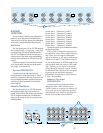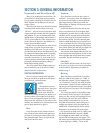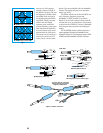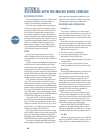
20
Do you need to read this section at all?
Many of you reading this manual have a lot
of experience in using large mixing consoles.
For you battle-scarred pros, Section 2 and the
Block Diagram will probably be all that you
need to look at.
Then there are those of you who have worked
extensively with smaller mixers such as our
CR-1604 — but who have less experience with
a larger, multi-bus console with lots of gazintas
and gozoutas. For you, we recommend at least
adding Section 4 (Recording) and/or Section 5
(PA) to your reading list. These chapters cover
some of the more unusual or less familiar fea-
tures of your new 8•Bus console.
Finally, there are those who are either new to
using mixers or just like to read even larger
quantities of our glib prose. For you, we have
provided this short section that discusses the ba-
sic concepts and procedures used in recording,
mixing and sound reinforcement work. If you
can make some sense of it, you’re ready for the
next two sections, which relate these concepts
to actually configuring and using a Mackie
8•Bus Series mixing console.
Also, if the system Block Diagram does not
look as familiar to you as the menu at McD’s,
spend a little time in this section.
GENERAL INFORMATION
Here is a primer covering a few important
ideas you should be on good terms with before
you sit down to a mixing console.
LEVELS
Microphones have very
low output levels. Power am-
plifiers have very high
output levels. One of the
functions of a mixing console is to amplify or at-
tenuate (reduce) these signal levels properly.
Since it’s easy to degrade the signal by not han-
dling levels well, and since it’s your hand on the
controls, you should be sure you know how much
gain to apply and where to apply it.
Noise
Every electronic circuit produces noise or
hiss or hash or buzz, and any noise present on
the input of an electronic circuit will be faith-
fully passed through. Turn it up high enough,
and you will hear the noise.
Headroom
Every electronic circuit also has a point of
overload — a clip point, where the voltage sim-
ply cannot rise any higher, no matter what the
input signal and your fader move would like.
This overload, or clipping, will show up as tooth-
grinding distortion.
Somewhere between the noise and the clip-
ping is an optimum level for your signal: high
enough above the noise floor to render the hiss
inaudible, and far enough below the distortion
point to allow range for loud peaks of music to
pass without clipping. This safe operating zone
might be called operating level or nominal level
or zero or perhaps line level. The range between
your operating level and clipping is called head-
room, which defines just how tall your signal can
be without having to duck for the rafters.
Your mission as a designated Master of the Lev-
els is to get the low-level signals up to line-level as
soon as possible and to keep them there as much
as possible. But don’t turn them up too loud.
Unity Gain
On a Mackie 8•Bus console, the easy way to
do this is to set all the level controls according
to the Sensitivity Adjustment procedure de-
tailed on page 1.
Metering
When the meters read 0dB, the level will ac-
tually be +4dBu at the outputs (or –10dBV at
the submaster outputs, if you’ve engaged their
+4/–10 switches). Don’t pay too much attention
to the meters. A meter is an aid, a window look-
ing onto part of the dynamic range of your signal,
and it will tell you if your level is in the ballpark,
so to speak.
Try to keep your signals in the middle range
of the meters, for the most part. If the signal is
always very low, you may not be getting the best
noise figures you can. If the meter LEDs are
always solidly lit from bottom to top, you are
likely distorting both the console and your re-
cording tape regularly. Keep the signal in the
middle, with occasional peaks into the yellow.
Remember, the top yellow LED of the meter
(+10) represents an audio level of +14dBu, and
the Mackie 8•Bus doesn’t clip until +28dBu.
Even banging the meters hard, you still have
around 14dB of headroom for your peaks. (The
L/R meters have an additional red LED segment
to show clipping at +28dBu.). There are not
SECTION 3: GENERAL INFORMATION
GENERAL
INFO


















